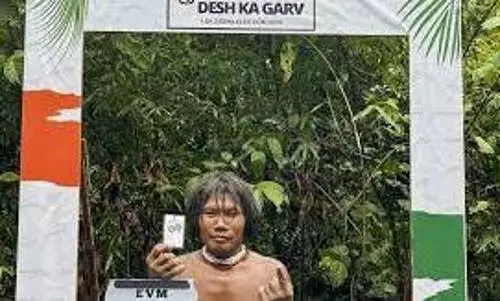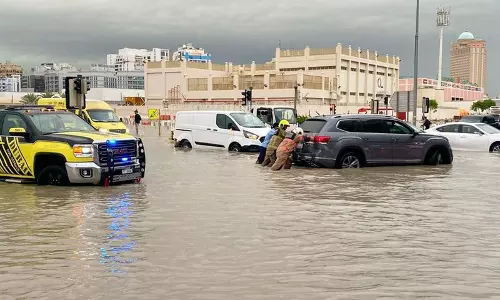
Ramjas College protests: ABVP has created a culture of fear, writes a DSE alumnus
text_fieldsBy Vasundhara
We used to be able to talk about Kashmir and self-determination, even until a year ago. Even if we were in the minority, we had an intact space for these discussions.
But the Akhil Bharatiya Vidyarthi Parishad (ABVP) has succeeded in creating a culture of fear. One of the scariest things that has emerged out of the current blazing political row between ABVP and left progressive forces is increasing self-censorship. The violence that unfolded at Ramjas College in Delhi this week is an all-new low in ABVP’s history of suppressing freedom of expression, and the only way to fight it is to continue reclaiming the space to talk about urgent issues – otherwise we risk the destruction of the university as a space for free thinking.
On Thursday, I was part of a group of approximately 500 protesters gathered outside the police station in ITO, Delhi. The agenda was to convert the complaints we had registered against ABVP members, the previous day, into an FIR. A senior police officer came out – we were told that this was the first time an officer had agreed to address protesters outside police headquarters – and said that one FIR has been lodged, but he can’t file multiple FIRs related to one incident. Apparently, this goes contrary to various Supreme Court judges’ recommendations in the past about filing as many FIRs as needed.
Friends who saw this police FIR said it actually has accusations against both ABVP and the opposing protesters, and made no distinction between them. People have apparently been booked under “rioting” and the “obstruction of officers’ duty”. The officer said that there will be a criminal investigation, and we can come forward with eyewitness accounts, testimonies, and evidence. I haven’t been to campus since Tuesday, but I’ve heard that Section 144 has been imposed and that police personnel have been deployed everywhere on campus, including in residential areas nearby.
The controversy began last week with a two-day seminar titled ‘Cultures of Protest’ organised by Ramjas College’s Literary Society and English department, meant to be held on 21 and 22 February. But it was violently disrupted by protesters from the ABVP on 21 February. They demanded that JNU student Umar Khalid’s (who was arrested briefly last year for sedition) talk ‘Unveiling the State: Regions in Conflict – The War in Adivasi Areas’ be cancelled, on the grounds that it was anti-national. They threw stones and bricks at the conference room, broke windowpanes, and beat up students outside. The talk was abruptly wrapped up and everyone had to be evacuated.
ABVP has a long history not just of intimidating students, but of also attacking or threatening to attack professors. So the violence currently unfolding at Ramjas College is not part of a new phenomenon. But it appears as if the ABVP has made an organisational decision to not yield any space to what they consider to be ‘anti-national’ activity. And they have faced increasing challenges from left progressive forces. Delhi University is far more conservative than Jawaharlal Nehru University, but with the Kiss of Love protests and Pinjra Tod activists, ABVP is feeling threatened by a growing fearlessness and mobilisation on the Left as well.
Since Tuesday, further violence has erupted inside and outside the college premises. And rumours have been floating of ABVP members on bikes at night, hunting people with rods; but I don’t know anyone who was hurt, and it’s plausible that these rumours are part of ABVP’s efforts to terrorise people.
On Wednesday, a ‘DU Fights Back March’ protesting Tuesday’s events was held, and a large number of students from the university, including those part of AISF, AISA, Pachhas, NSI, Pinjra Tod and other campus groups, as well many unaffiliated students were present. It was meant to start at 1 pm and students were supposed to march from Ramjas to the Maurice Nagar police station.
But when I, along with other students, reached Ramjas College, the police had shut the gates. We heard that students were getting picked up and beaten up inside by ABVP goons. Some ABVP members were eventually brought outside and put into police vans, but they quickly came back out. It seemed the police had little will to detain them.
They then began attacking us, the people gathered outside. When they were held off from the front by police, they attacked us from behind. They threw huge stones at us from behind walls. Many people were hit within one or two feet of the police. A friend was thrown onto the road, another had a brick hit the back of his head and sustained a nasty head injury. They were taken to hospital by the police. Women had to deal with lewd gestures and comments like “Azaadi chahiye? Dikhata hoon azaadi! (You want Azaadi? I'll show you!)” The only thing the police managed to do was to pull them back when they began charging towards us. This confrontation outside Ramjas went on for over an hour.
We began marching to Maurice Nagar police station with the police, all the while being attacked with stones by ABVP members who were shouting slogans like “Bharat mein agar rehna hoga, Vande Mataram kehna hoga (If you want to stay in India, you will have to say Vande Mataram)” and “Bharat mata ki jai (All hail mother India!)”. They wouldn’t attack when we turned to look at them, they only attacked from behind. They threw wrenches and spanners at the crowd; they had clearly come prepared. Then they blocked us in front of the Arts department, tried to attack the march and hurled stones and bricks.
I don’t know if paranoia is the right word to use here – it’s more like everyone was rightfully tense and stressed. People would flinch at the slightest sight of a flying object in the air, expecting another stone.
We were finally allowed to enter the police station and register our complaints on behalf of the two people who had had returned with injuries, against eight ABVP members (including four women) and others. Once inside, we were told the police will not entertain so many individual complaints and that instead, we should compile all the complaints into one consolidated complaint. This consolidated complaint is now being demanded to be the basis for registering the FIR.
While we were inside the station, the police cracked down outside. They lathi-charged the protesters brutally, beat up men and women and detained everyone in two vans. All this while, ABVP members stood aside with complete impunity and cheered and clapped and hooted. When students began to scatter because of the sudden crackdown, many who were found to be alone were caught and beaten up by the ABVP. Women were detained after dark by the police, which is against the law.
At the station, I met a woman who had come to the police station alone. She had bruises on her face and arms. A friend of hers had lost his phone and she had been helping him look for it when ABVP goons, men and women, began attacking her. They beat her up really badly, pulling her hair and her legs in all directions, before the media and police arrived and stopped the lynch mob. “If someone hadn’t come, they would have killed me,” she told me.
Our plans going forward are to strategise, and organise more effectively. So far, protests and discussions have been occurring spontaneously. Meanwhile, students have been recording accounts of the violence.
But perhaps the most frightening outcome of all this has been the self-censorship. I heard that there was meant to be a programme to commemorate Kashmiri women’s resistance at Ambedkar University on Thursday, but it was cancelled because of the Ramjas incident. A friend mentioned that the reason given was that the present political atmosphere called for a more 'balanced' panel. The Jodhpur row over Nivedita Menon is another example. These are good academics, and people are now going to be scared and not call them to speak. Self-censorship is continuing despite us saying that we won’t be cowed down, and that’s what ABVP has managed to do – create fear amongst everyone.
(As told to Maya Palit)
Vasundhara is an alumna of Delhi School of Economics.
The Ladies Finger (TLF) is a leading online women’s magazine delivering fresh and witty perspectives on politics, culture, health, sex, work and everything in between.























